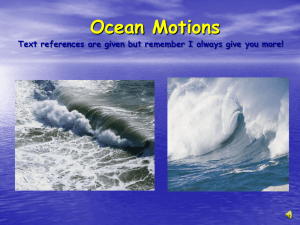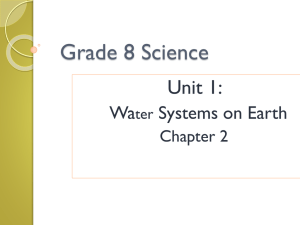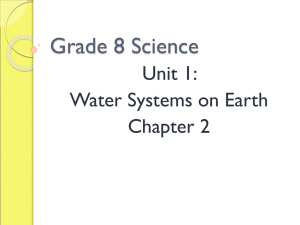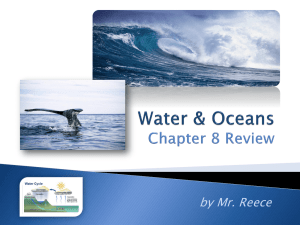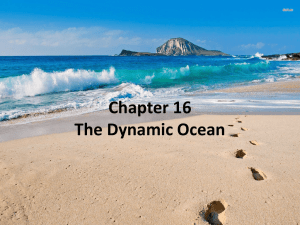CHAPTER 14 - Southern Local Schools
advertisement
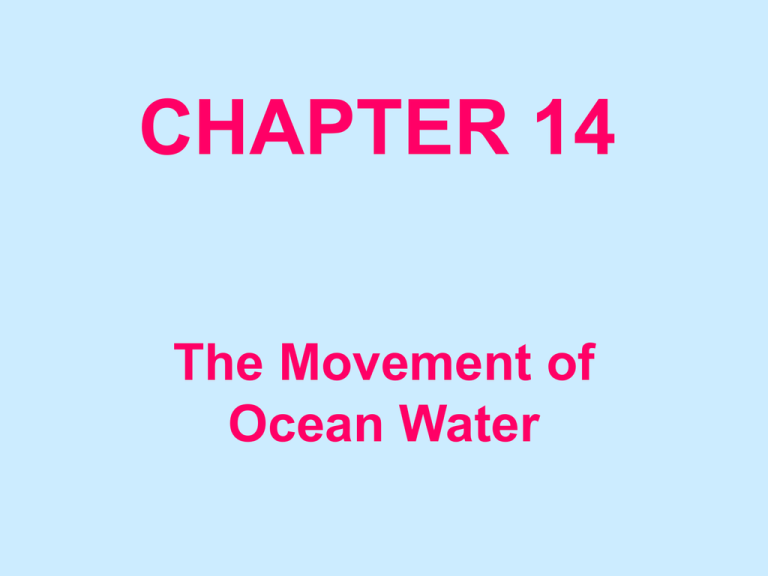
CHAPTER 14 The Movement of Ocean Water Solar Radiation • One of the fundamental energy sources for all ocean currents is solar radiation. Uneven heating of the Earth by the sun creates differences in air pressure. These differences create wind, which drives surface currents. The sun’s energy also creates temperature differences in ocean water, driving deep currents. IS THAT A FACT!! • The strongest and largest ocean current is the Antarctic Circumpolar Current, which is estimated to flow at a rate of 125 million cubic meters per second. • One of the fastest ocean currents is the Somali Current, in the western Indian Ocean, which flows at a speed of 14.5 km/h. • The Wendell Sea, where the Antarctic Bottom Water is thought to originate, has the clearest water of any sea. Its clarity has been recorded to a depth of nearly 80 m. In other words, water collected from the upper 80 m of the Weddell Sea is as clear as you would find in a glass of distilled water. Surface Currents • Stream-like movements of water that occur at or near the surface of the ocean are called surface currents. Some Surface currents are several thousand kilometers in length, traveling across entire oceans. The Gulf Stream, which is one of the longest surface currents, transports 25 times more water than all the rivers in the world. Surface currents are controlled by three factors: global winds, the Coriolis effect, and continental deflections. These three factors keep surface currents flowing in distinct patterns around the Earth. Global Winds • Have you ever blown gently on a cup of hot chocolate? You may have noticed ripples moving across the surface. These ripples are caused by a tiny surface current created by your breath. In much the same way, winds blowing across the Earth’s surface create surface currents in the ocean. Surface currents can reach the depths of several hundred meters and lengths of several thousand kilometers. • Surface currents near the equator generally flow from east to west, but surface currents closer to the poles tend to flow from west to east. The Coriolis Effect • The curving of moving objects from a straight path due to the Earth’s rotation is called the Coriolis effect. Continental Deflections • If the Earth’s surface were covered only with water, surface currents would travel freely across the globe in a very uniform pattern. However, we know that this is not the case – continents rise above sea level over roughly one-third of the Earth’s surface. When surface currents meet continents, they deflect, or change direction. IS THAT A FACT !! • The Earth’s rotation affects ocean currents directly by causing currents to circle in opposite directions on either side of the equator. Earth’s rotation also affects the wind patterns, which in turn drive surface currents. Taking Temperatures • 1. All three factors – global winds, the Coriolis effect, and continental deflections—work together to form a pattern of surface currents on Earth. But currents are also affected by the temperature of the water in which they arise. Warm-water currents begin near the equator and carry warm water to other parts of the ocean. Cold-water currents begin closer to the poles and carry cool water to other parts of the ocean. • 2. The following map shows Earth’s surface currents. Warm-water currents are shown in red arrows, and cold-water currents are shown as blue. Physics Connection • While winds are responsible for ocean currents, the sun is the initial energy source of the currents. Because the sun heats the Earth more in some places than in others, convection currents are formed, which cause winds to blow. Deep Currents • Deep currents are stream-like movements of ocean water far below the surface. Deep currents are not directly controlled by wind or the Coriolis effect. Instead, they form in parts of the ocean where water density increases. Two main factors - temperature and salinity combine the affect the density of ocean water How Deep Currents Form Decreasing Temperature In Earth’s polar regions, cold air chills the water molecules at the ocean ‘s surface, causing them to slow down and move closer together. This decreases the water’s volume, making the water denser. The dense water sinks and eventually travels towards the equator as a deep current along the ocean floor. How Deep Currents Form (cont.) Increasing Salinity Through Freezing Salinity is a measure of the amount of dissolved solids in a liquid. If the ocean water freezes at the surface, ice will float on top of water because ice is less dense than liquid water. The dissolved solids are squeezed out of the ice and enter the liquid water below the ice, increasing the salinity. Because this water contains more dissolved solids, its density also increases. How Deep Currents Form (cont.) Increasing Salinity Through Evaporation Another way salinity increases is through evaporation of surface water, which removes water but leaves solids behind. This is especially common in warm climates. Increasing salinity through freezing or evaporation causes water to become denser and sink to the ocean floor, becoming a deep current. Movement of Deep Currents • The movement of deep currents as they travel along the ocean floor is very complex. Differences in temperatures and salinity, and therefore in density, cause variations on deep currents. For example, the deepest current, the Antarctic Bottom Water, is denser than the North Atlantic Deep Water. The Antarctic Bottom Water is so dense that it moves incredibly slowly—it takes 750 years for water in this current to make it from Antarctica’s coastal waters to the equator! Currents That Stabilize Climate • Although surface currents are generally much warmer than deep currents, their temperatures do vary. Surface currents are classified as warm-water currents or cold-water currents. Because they are warm or cold, surface currents affect the climate of the land near the area where they flow. For example, warm-water currents create warmer climates in coastal areas. Likewise, cold-water currents create cooler climates in coastal areas that would otherwise be much warmer. Current Variations – El Nino • The surface currents in the tropical regional of the Pacific Ocean usually travel with the trade winds from east to west. This builds up warm water in the western Pacific and causes upwelling in the eastern Pacific. Upwelling is a process in which cold, nutrient-rich water from the deep ocean rises to the surface and replaces warm surface water. The warm water is blown out to sea by prevailing winds. But every 2 to 12 years, the South Pacific trade winds move less warm water to the western Pacific. As a result, surface water temperatures along the coast of South America rise. Gradually, this warming spreads westward. This periodic change in the location of warm and cool surface waters in the Pacific Ocean is called El Nino. El Nino not only affects surface waters but the atmosphere, resulting in changes in global weather patterns. Effects of El Nino • El Nino alters weather patterns enough to cause disasters, such as flash floods and mudslides in areas of the world that normally receive little rain. While some regions flood, regions that usually get a lot of rain may experience droughts, which can lead to crop failures. QUIZ • Give two characteristics and one example of each type of current. 1.Sample answer: Surface currents occur at the surface of the ocean and are influenced by the Coriolis effect; the Gulf Stream is an example. 2.Sample answer; deep currents occur deep in the ocean and are influenced by differences in water density; the Antarctic Bottom Water is an example. Waves • We all know what ocean waves look like. Even if you’ve never been to the seashore, you’ve most likely seen waves on television. But what are ocean waves? How do they form and move? Are all waves the same? And what do they do besides drop shells and sand dollars on the beach? Anatomy of a Wave • Waves are made up of two main components—crests and troughs. A crest is the highest point of a wave, and a trough is the lowest point. • The distant between two adjacent wave crests or wave troughs is a wavelength. The vertical distance between a wave’s crest and its trough is a wave height. Specifics of Wave Movement • Waves not only come in different sizes, but also travel at different speeds. To calculate wave speed, scientists must know the wavelength and the wave period. Wave period is the time between the passage of two wave crests (or troughs) at a fixed point. Dividing wavelength by wave period gives you wave speed as shown below: • wavelength (m) = wave speed (m/s) wave period (s) • For any given wavelength, an increase in the wave period will decrease the wave speed, and a decrease in the wave period will increase the wave speed. Types of Waves • As you learned earlier in this section, waves form by other mechanisms. Underwater earthquakes and landslides as well impacts by cosmic bodies can form different types of waves. The sizes of the different types of waves can vary, but most move the same way. Depending on their size and the angle at which they hit the shore, waves can generate a variety of near-shore events, some of which can be dangerous to humans. Deep-Water Waves and ShallowWater Waves • Have you ever wondered why waves increase in height as they approach the shore? The answer has to do with the depth of the water. Deepwater waves are waves that move in water that is deeper than one-half of their wavelength. When the waves reach water that is shallower than one-half of their wavelength, they begin to interact with the ocean floor. These waves are called shallow-water waves. The next slide shows how deep-water waves become shallowwater waves as they move towards the shore. Deep-Water Waves and ShallowWater Waves (contd.) • As deep-water waves become shallow-water waves, the water particles slow down and build up. This forces more water between wave crests and increases wave height. Gravity eventually pulls the high wave crests down, causing them to crash into the ocean floor as breakers. The area where waves first begin to tumble downward, or break, is called the breaker zone. Waves continue to break as they move from the breaker zone to the shore. The area between the breaker zone and the shore is called the surf. Deep-Water Waves and ShallowWater Waves (cont.) • When waves crash on the beach head-on, the water they moved through flows back to the ocean underneath new incoming waves. This movement of water, which carries sand, rock particles, and plankton away from the shore is called an undertow. Deep-Water Waves and ShallowWater Waves (cont.) • When waves hit the shore at an angle, they cause water to move along the shore in a current called a longshore current. Longshore currents are responsible for most sediment transport in beach environment. This movement of sand and other sediment both tears down and builds up the coastline. “Science Humor” Q: What do two oceans say when they meet? A: Long time no see! Open-Ocean Waves • Sometimes waves are called whitecaps form in the open ocean. Whitecaps are white, foaming waves with very steep crests that break in the open ocean before the waves get closer to the shore. These waves usually form during stormy weather, called swells. Swells are rolling waves that move in a steady procession across the ocean. Swells have longer wavelengths than whitecaps and can travel for thousands of kilometers. CONNECT TO ENVIRONMENTAL SCIENCE • Beach nourishment involves dredging enormous amounts of sand from the ocean floor and pumping it back onto the shoreline, rebuilding beaches that have been eroded by long-shore currents. It is a common, but controversial, practice along the Atlantic Coast. Some people think the natural erosion of beaches should not be disrupted. Beach erosion is influenced by other human activities, however. For example, artificial dams prevent sediment from reaching protective barrier islands and the dredging of ship channels disrupts the natural movement of sediment along the coast. Tsunamis • Professional surfers often travel to Hawaii to catch some of the highest waves in the world. But even the best surfers would not be able to handle a tsunamis. Tsunamis are waves that form when a large volume of ocean water is suddenly moved up or down. This movement can be caused by underwater earthquakes, volcanic eruptions, landslides, underwater explosions, or the impact of a meteorite or comet. The majority of tsunamis occur in the Pacific Ocean because of the greater majority of earthquakes in that region. Tsunamis (cont.) • When tsunamis near continents, they slow down and their wavelengths shorten as they interact with the ocean floor. As tsunamis get closer together, their wave height increases. Tsunamis can reach more than 30 m in height as they slam into the coast, destroying just about everything in their path. The powerful undertow created by a tsunamis can be as destructive as the tsunamis itself. WEIRD SCIENCE • In 1946, the crew of a freighter anchored offshore near Hilo, Hawaii, were astounded to witness an enormous tsunamis crash on the shore, crushing buildings, felling trees, and carrying boats, piers and rocks ashore. Moments before, the wave had passed beneath the freighter unnoticed! IS THAT A FACT!! • The highest recorded tsunamis was 64 m (210 ft) high; it struck Kamchatka, Siberia, in 1737. Storm Surges • A storm surge is a local rise in sea level near the shore that is caused by strong winds from a storm such as a hurricane. Winds form a storm surge by blowing water into a big pile under the storm. As the storm moves onto the shore, so does the giant mass of water beneath it. Storm surges often disappear as quickly as they form, making them difficult to study. Storm surges contain a lot of energy and can reach about 8 m in height. This makes them the most destructive part of hurricanes. Tides • You have learned how winds and earthquakes can move ocean water. But there are less-obvious forces that continually move ocean water in regular patterns called tides. Tides are daily movements of ocean water that changes the level of the ocean’s surface. Tides are influenced by the sun and the moon, and they occur in a variety of cycles. The Lure of The Moon • The phases of the moon and their relationship to the tides were first discovered more than 2,000 years ago by a Greek explorer named Pytheas. But Pytheas, and other early investigators could not explain the relationship. A scientific explanation was not given until 1687, when Sir Isaac Newton’s theories on the principle of gravitational pull were established. The gravity of the moon pulls on every particle of the Earth, but the pull is much more noticeable in liquids than in solids. This is because liquids move more easily. Even the liquid in an open soft drink is slightly pulled by the moon’s gravity. The Lure of The Moon contd. • Gravitational forces from both the sun and the moon continuously pull on the Earth. Although the moon is much smaller than the sun, the moon’s gravity is the dominant force behind Earth’s tides. High Tide and Low Tide • How high, tides get and how often they occur depend on the position of the moon as it revolves around the Earth. The moon’s pull is the strongest on the part of the Earth directly facing the moon. When that part happens to be a part of the ocean, the water there bulges towards the moon. High Tide and Low Tide • At the same time, water on the opposite side of the Earth bulges due to the motion of the Earth and the moon around each other. These bulges are called high tides. Notice in Figure 18 how the position of the moon causes the water to bulge. Also notice that when the high tide occurs water is drawn away from the area between the high tides, causing a low tide to form. Tidal Variations • The sun also affects tides. The sun is much larger than the moon, but it is also much farther away. As a result, the sun’s influence on tides is less powerful than the moon’s influence. The combined forces of the sun and the moon on the Earth result in tidal ranges that vary based on the position of all three bodies. A tidal range is the difference between levels of ocean water at high tide and low tide. Spring Tides • When the sun, Earth and the moon are in alignment with one another, spring tides occur. Spring tides are tides with maximum daily tidal range that occur during the new and full moon. Spring tides occur every 14 days. The first time spring tides occur is when the moon is between the sun and Earth. The second time spring tides occur is when the moon and the sun are on opposite sides of the Earth. Neap Tides • When the sun, Earth and the moon form a 90 degree angle, neap tides occur. Neap tides are tides with minimum daily tidal range that occur during the first and third quarters of the moon. Neap tides occur halfway between the occurrence of spring tides. When neap tides occur, the gravitational forces on the Earth by the sun and moon work against each other. WEIRD SCIENCE • The moon also creates tides in our atmosphere called lunar winds. Lunar winds move eastward in the morning and westward in the evening. Although these tides travel only 0.08 km/h they can be detected by studying slight fluctuations in weather patterns. CONNECT TO ENVIRONMENTAL SCIENCE • Tidal energy is one of the oldest renewable resources used by human civilizations. Tidal mills were used in England and France more than 900 years ago. Today, there are tidal power plants on the coast of France; on the Barents Sea, in Russia; and at Royal, Nova Scotia, in Canada. QUIZ 1. Why are tides more noticeable in Earth’s oceans than on its land? 2. Why do spring tides exhibit such extremes of range? 1. Because the oceans are liquid, they flow more easily than solid rock. 2. When the moon, the sun, and the Earth are aligned, as they are during spring tides, the tidal pull is maximized.
